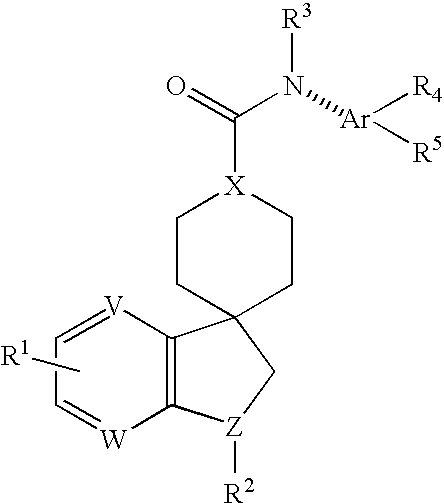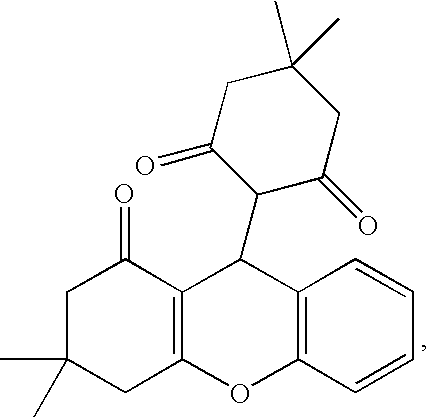Method for treating circadian rhythm disruptions
a circadian rhythm and disruption technology, applied in the field of circadian rhythm disruption treatment, can solve the problems of affecting the quality of life of older people, so as to block the phase-shifting effect of light and reduce the frequency of circadian rhythm disorders
- Summary
- Abstract
- Description
- Claims
- Application Information
AI Technical Summary
Benefits of technology
Problems solved by technology
Method used
Image
Examples
example 1
[0104] Y5 receptor antagonist assay:
[0105] To identify a potent Y5 antagonist for treatment of circadian rhythm disorders in humans, the cloned human Y5 receptor is used in the primary assay. Vectors expressing either the 455 amino acid form (See, e.g., U.S. Pat. No 5,602,024) or a 10 amino acid, N-terminally shorter form (See, e.g., U.S. Pat. No. 5,919,901) can be introduced into cell lines to obtain cells which express the human Y5 receptor. Binding of [125I]PYY (NEN) to membrane preparations from cells expressing the cloned human Y5 receptor are performed in 0.2 ml of 25 mM Tris buffer (pH 7.4) containing 10 mM MgCl2, 1 mM PMSF, 0.1% bacitracin and 0.5% bovine serum albumin. Membranes (10-300 μg / ml) prepared from LMtk-, COS-7, HEK or CHO cells expressing Y5 receptors, are incubated at 25° C. for 120 min with [125I]PYY (25 pM) in the presence of several concentrations of compounds to be evaluated. Bound and free peptides are separated by filtration using a GF / C glass filter preso...
example 2
[0107] Assessment of behavioral rhythms:
[0108] For the recording of locomotor activity rhythms in rodents, animals would be maintained under a standard light-dark cycle (12:12 or 14:10, depending upon the species or strain of rodent) for several weeks prior to the start of each experiment. Animals would be housed individually with access to a running wheel in the cage and wheel-running activity would be recorded continuously (e.g., using a Chronobiology kit, Actiview software, or another biological rhythm analysis software package). Food (rodent chow) and water would be available ad libitum.
[0109] (1) To evaluate whether NPY5 receptor antagonist treatment phase-shifts the circadian rhythm of locomotor activity, one would administer the NPY5 receptor antagonist or vehicle to animals at different circadian times while the animals were maintained under dim red light conditions (<15 lux of light) in “constant dark” conditions. Animals would be dosed with the NPY5 receptor antagonist a...
example 3
Determine the effect of a Y5 antagonist, L-152804 on phase shifts of the circadian rhythm
[0114] A. Effect of L-152804 on circadian rhythms
[0115] Male golden hamsters are housed individually under a Light-Dark (LD) cycle of 14:10 upon arrival from the supplier for 2 weeks. All animals are housed with a running wheel to measure activity. The animals are then transferred to a constant dark (DD) cycle for 2 weeks and activity records from the running wheel are used to determine circadian time (CT) 14.
[0116] Two groups of hamsters are treated orally with vehicle (0.5% methocel) or L-152804 at 50 mg / kg, then the animals are returned to their home cages and activity recorded for 10 days by monitoring the time the animals spend on a running wheel. A shift in the peak time of activity would indicate a Y5 antagonist can shift the circadian rhythm.
B. Effect of L-152804 on light induced phase shifts in the circadian rhythm
[0117] Male golden hamsters are housed individually under a Light-...
PUM
| Property | Measurement | Unit |
|---|---|---|
| pH | aaaaa | aaaaa |
| concentrations | aaaaa | aaaaa |
| clock time | aaaaa | aaaaa |
Abstract
Description
Claims
Application Information
 Login to View More
Login to View More - R&D
- Intellectual Property
- Life Sciences
- Materials
- Tech Scout
- Unparalleled Data Quality
- Higher Quality Content
- 60% Fewer Hallucinations
Browse by: Latest US Patents, China's latest patents, Technical Efficacy Thesaurus, Application Domain, Technology Topic, Popular Technical Reports.
© 2025 PatSnap. All rights reserved.Legal|Privacy policy|Modern Slavery Act Transparency Statement|Sitemap|About US| Contact US: help@patsnap.com



